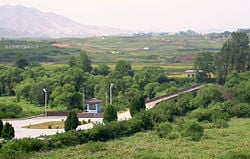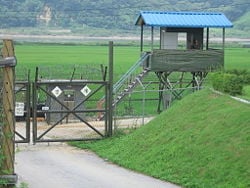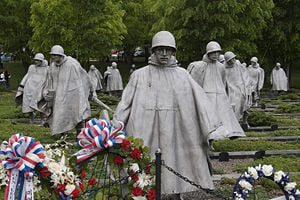Division of Korea
The division of Korea into North Korea and South Korea stems from the 1945 Allied victory in World War II, ending Japan's 35-year occupation of Korea. Through General Order No. 1, issued by General Douglas MacArthur, the United States and the Soviet Union were to supervise the surrender of Japanese forces in their sectors, divided by the 38th Parallel, as well as temporarily establish their respective military governments until such time as Korea was either administered under an international trusteeship or achieved independence. In 1948, the Soviet Union refused to participate in the United Nations supervised peninsula-wide democratic elections for a new government, leading to the UN's recognition of the Republic of Korea (South Korea) as the sole legitimate government in Korea.
The Korean War (1950-1953) and its Armistice Agreement left the two Koreas permanently separated by the DMZ—roughly approximate to the 38th Parallel and through which runs the Military Demarcation Line—remaining technically at war through today. North Korea's communist government has presided over a state-controlled economy historically dependent upon massive aid from Russia and China to survive. South Korea, meanwhile, has developed into one of the world's leading economies, employing free enterprise economic policies as well as fostering a democratic government. Since the 1990s, the two Koreas have held two symbolic summit meetings (in 2000 and 2007) and slightly increased economic cooperation, but reunification still seems a relatively distant goal, barring unexpected events.
|
Jeulmun Period
|
Historical Background
End of World War II (1939–1945)
Main article: World War II
In November 1943, U.S. president Franklin Roosevelt, British prime minister Winston Churchill and China's Generalissimo Chiang Kai-shek met at the Cairo Conference in part to discuss what should happen to Japan's colonies, and agreed that Japan should lose all the territories it had conquered by force because it might become too powerful. In the declaration after that conference, a joint statement mentioned Korea for the first time. The three powers declared that they, "mindful of the enslavement of the people of Korea are determined that in due course [emphasis added] Korea shall become free and independent." For some Korean nationalists who wanted immediate independence, the phrase "in due course" caused great dismay. Roosevelt later proposed to Joseph Stalin that a substantial number of years elapse before full Korean independence; Stalin demurred, saying that a shorter period of time would be desirable. In any case, discussion of Korea among the Allies waited until imminent victory over Japan.
With the war's end in sight in August 1945, the Allied leaders still lacked consensus on Korea's fate. Many Koreans on the peninsula had made their own plans for the future of Korea, which did not foresee the re-occupation of Korea by foreign forces. Two days following the atomic bombing of Hiroshima on August 6, 1945, Soviet leaders invaded Manchuria, as per Stalin's agreement with Roosevelt during the Yalta Conference.[1] The American leaders worried that the whole peninsula might be occupied by the Soviet Union, and feared this might lead to a Soviet occupation of Japan. Later events showed those fears well-founded.
The Soviet forces moved rapidly southward on the Korean peninsula directly toward the United States forces moving northward. On August 10, 1945 two young colonels, Dean Rusk and Charles Bonesteel, supervised by Brigadier General George Lincoln, working on extremely short notice, proposed the 38th parallel as the administrative line for the two armies. They used a small National Geographic map of Asia to decide on the 38th parallel, dividing the country approximately in half while leaving the capital Seoul under American control, a prime consideration. The two men had been unaware that forty years previous, Japan and Russia had discussed splitting Korea along the same parallel. The officers forwarded their recommendation which was incorporated into General Order No. 1 for the administration of postwar Japan. More interested in obtaining the northern Japanese island of Hokkaido, Stalin agreed to the dividing line.
As a colony of Japan, the Korean people had been systematically excluded from important posts in the administration of Korea. General Abe Nobuyuki, the last Japanese Governor-General of Korea, conferred with a number of influential Koreans since the beginning of August 1945 to prepare the hand-over of power. On August 15, 1945, Yo Un Hyong, a moderate left-wing politician, agreed to take over. He took charge of preparing the creation of a new country and worked hard to build governmental structures. On September 6, 1945, a congress of representatives convened in Seoul. The foundation of a modern Korean state took place just three weeks after Japan's capitulation. The government, predominantly left wing, comprised of resistance fighters who agreed with many of communism's views on imperialism and colonialism.
After World War II
In the South
On September 7, 1945, General MacArthur appointed Lieutenant General John R. Hodge to administer Korean affairs, Hodge landing in Incheon with his troops the next day. The "Provisional Government of the Republic of Korea" sent a delegation with three interpreters, but he refused to meet with them.
The American military authorities focused on dealing with Japan's surrender and the repatriation of Japanese to Japan. Little changed at first in the administration of the south; officials then serving under the Japanese authorities remained in their positions. The United States dismissed the Japanese governor general in the middle of September, but many Japanese officials stayed in office until 1946. Those decisions angered many Koreans.
The United States occupation authorities in South Korea faced numerous communist attempts to foment revolution from 1945 to 1948. The Soviet Union not only put in place a communist dictatorship in the north, it sought to take over the south through overthrowing the unstable government there. The United States supported Princeton-educated Syngman Rhee, who moved back to Korea after decades of exile in the United States, to provisionally lead the country. Rhee had proven himself a patriot dedicated to democracy and free enterprise. Rhee staunchly countered armed rebellions in the south seeking to overthrow the provisional government and install a Soviet-backed communist dictatorship. To complicate matters, a number of political candidates proclaimed communist allegiance and sympathies, openly attempting to rally support of a communist dictatorship in the south. Clearly, the goal of communists in Korea, north and south, lay in establishing a communist dictatorship on the Korean peninsula. From 1945 to 1950, between 30,000[2] and 100,000 people would lose their lives in those battles.[3]
In August 1948, the United States supervised a democratic election south of the 38th parallel in compliance with the United Nations mandate for a free and open election in Korea. The Soviet Union refused to allow the northern sector to participate, leading the United Nations to declare Syngman Rhee the legitimate president of Korea and the Republic of Korea the sole legitimate government on the Korean Peninsula. The United States then withdrew its forces to Japan, leaving South Korea with a police force at best to defend itself. In January 1950, the United States made public statements that the United States considered Korea beyond its defense perimeter, leading the North and Soviet Union to believe that the U.S. would not aid South Korea if attacked.
In the North
- Main Articles: Workers Party of North Korea North Korea History of North Korea
In August 1945, the Soviet Army established the Soviet Civil Authority to rule the country while establishing a domestic regime controlled by the USSR. Russia established provisional committees across the country putting communists into key positions. In March 1946, Russia instituted land reform, dividing land from Japanese and collaborator land owners and distributing it to farmers. Kim Il-sung, brought by the Soviets to lead the north in September 1945, initiated a sweeping land reform program in 1946. Organizing the many civilians and farm hands under the people's committees, Kim used the power of government to seize control of land owned by Koreans. He allowed landlords a common share of land with farmers. Of course, farmers who had been disenfranchised during the Japanese colonial rule enjoyed the gift. Many of those who owned land though, seeing the writing on the wall, fled to the south. In a single stroke, the northern section of Korea lost many talented and educated leaders while the south gained them. Of course, in the history of communist domination, the educated and propertied people have suffered persecution and extermination first; North Korea followed the pattern. According to the U.S. military government, 400,000 northern Koreans fled south as refugees.[4]
Kim next seized control of key industries, placing them under control of the North Korean Communist Central Committee. The Japanese had concentrated heavy industry in the north, cultivating agriculture in the south. Seizing control of factories, and placing the farm land in the hands of peasants, Kim further destabilized a weak economy. He had the benefit of massive aid from Russia, especially weapons. From the beginning of the Soviet occupation of North Korea, Kim concentrated on building North Korea's military power.
In February 1946 Kim Il-sung, who had spent the last years of the war training with Soviet troops in the Russian Far East, formed a provisional government called the North Korean Provisional People's Committee under his control. He moved systematically to remove rivals and consolidate power. At the local levels, people's committees eradicated Koreans of wealth and position, confiscating much of their land and possessions. As a consequence many of north Korea's leaders disappeared, presumed dead.
Establishment of two Koreas
With tensions growing rapidly between the formerly allied United States and Soviet Union, a stalemate existed in discussions on how to reconcile the provisional governments. The United States brought the problem before the United Nations in the fall of 1947. The USSR opposed UN involvement. The UN passed a resolution on November 14, 1947, declaring that free elections be held, after which US and Soviet troops must be withdrawn, and a UN commission for Korea created. The Soviet Union, although a member with veto powers, boycotted the voting, refusing to consider the resolution binding.
In April 1948, a conference of organizations from the north and the south met in Pyongyang. That conference stalemated, the Soviets boycotting the UN-supervised elections in Korea, resulting in no UN supervision of elections in the north. On May 10, the south held elections. Syngman Rhee, won the popular electing in the midst of a tumultuous political environment. Left-wing parties, following the Soviet Union's marching orders, boycotted the election, seeking to instigate wide-spread instability through compromising the election. In spite of North Korea's, and communist allies in the south's, best efforts, the Republic of Korea began life on August 13, when Syngman Rhee's elected government assumed power from the United States provisional government.
Korean War
- Main Article: Korean War
In the North, Kim Il-sung declared the Democratic People's Republic of Korea on September 9, 1948, with Kim the prime minister. The installation of the DPRK took place without elections, facilitated by the Soviet Union. The Republic of Korea (South Korea) declared its independence on August 15.
The division of Korea, after existing as a sovereign unified kingdom from 932 to 1910, struck both the North and the South governments as unacceptable. The clash of ideologies, communist and democratic/free enterprise, in Korea made the 38th parallel the flash point for the new Cold War.
From 1948 until the start of the Korean War on June 25, 1950, North Korean forces repeatedly instigated bloody conflicts along the border. On June 25, 1950, Kim Il-sung sprung his full military force, with the backing of the Soviet Union, against the South. The Cold War's first hot war had begun. The United Nations, led by the United States, quickly came to South Korea's defense. The Soviet Union supported the war behind the scenes while Communist China sent 300,000 troops in support of North Korea. The war raged until July 27, 1953 with the signing of an armistice that put in place a truce which still stands today. A three-mile wide buffer zone between the states was created, the Demilitarized Zone or DMZ.
After the Korean War (1953–present)
North and South Korea have never signed a formal peace treaty, only declaring a truce. From 1948 to 1992, authoritarian governments, usually ruled by a military president, had reigned in South Korea. The South Koreans tolerated authoritarian rule in the face of a Kim Il-sung determined to reunify the Korean peninsula by military force. The North failed in several assassination attempts on South Korean leaders, most notably in 1968, 1974 and 1983; the South Korean military frequently found invasion tunnels under the DMZ.
In the late 1990s, with the South having transitioned to civilian democracy, the success of its Nordpolitik policy, and power in the North having been assumed by Kim Il-sung's son, Kim Jong-il, the two nations began to cautiously engage for the first time, with the South upholding its Sunshine Policy beginning in 1998. The two Koreas have adopted an unofficial Unification Flag, representing Korea at international sporting events. The South has come to provide the North with significant aid and cooperative economic ventures (although China provides far more economic aid and investment), and the two governments have cooperated in organizing meetings of separated family members and limited tourism of North Korean sites. The two states, however, still refuse to recognize each other. North Korea's program to manufacture nuclear weapons and delivery systems has attracted condemnation by the United Nations and North Korea's neighbors.
The apportionment of responsibility for the division is much debated, although the older generation of South Koreans generally blame the North's communist zeal for instigating the Korean War. Many in the younger generation in South Korea see the division as a byproduct of the Cold War, criticizing the United States' role in the establishment of separate states, the presence of US troops in the South, and hostile policies against the North. Although those differences exist in South Korea, by far the prevailing posture of South Koreans has been peace through strength. In the North, Kim Jong-il has no interest in popular sentiment among the North Koreans. Kim's greatest concern now is how his regime can survive without falling to the same fate as Romania's Nicolae Ceauşescu.
See also
- History of North Korea
- History of South Korea
- Korean reunification
- Korean Workers Party for information on the formation of North Korea
Notes
- ↑ J. Samuel Walker. Prompt and Utter Destruction: Truman and the Use of Atomic Bombs against Japan. (Chapel Hill, NC: University of North Carolina Press, 2005. ISBN 080785607X)
- ↑ Allan R. Millett. The War for Korea, 1945-1950: A House Burning. (Lawrence, KS: University Press of Kansas, 2005. ISBN 0700613935)
- ↑ Jon Halliday and Bruce Cumings. Korea: The Unknown War. (New York: Viking Press, 1988. ISBN 0670819034)
- ↑ Millett, 2005
ReferencesISBN links support NWE through referral fees
- Armstrong, Charles K. The North Korean Revolution: 1945-50. Ithaca, NY: Cornell University Press, 2003. ISBN 0801489148
- Boose, Donald W., Jr. "Portentous Sideshow: The Korean Occupation Decision." in Parameters (Winter 1995).
- Cho, Soon Sung. Korea in World Politics, 1940-1950: An evaluation of American responsibility. Berkeley, CA: University of California Press, 1967. OCLC 423708
- Cho, Soon Sung. The genesis of tragedy: division of Korea: analysis of American decision-making process. Seoul, Korea: Institute of Foreign Affairs and National Security, 1980. OCLC 40047623
- Dobbs, Charles M. The Unwanted Symbol: American Foreign Policy, the Cold War, and Korea, 1945-1950. Kent, OH: Kent State University Press, 1981. ISBN 0873382587
- Hasegawa, Tsuyoshi. Racing the Enemy: Stalin, Truman, and the Surrender of Japan. Cambridge, MA: The Belknap Press of Harvard University, 2005. ISBN 0674016939
- Hess, Robert Preston. The background and origins of the thirty-eighth parallel division of Korea. Unpublished thesis (M.A.). Clark University, 1960. OCLC 37048617
- Kim, Hyung-Kook. The division of Korea and the alliance making process: internationalization of internal conflict and internalization of international struggle, 1945-1948. Lanham, MD: University Press of America, 1995. ISBN 978-0819198679
- Lee, Jongsoo James. The Partition of Korea after World War II: A Global History. New York: Palgrave Macmillan, 2007. ISBN 0230602274
- Lee, Won Sul. 1982. The United States and the division of Korea, 1945. Seoul: Kyung Hee University Press. OCLC 8949166
- Matray, James Irving, "Korea's Partition: Soviet-American Pursuit of Reunification, 1945-1948." Parameters (Spring 1998).
- Matray, James Irving. The Reluctant Crusade: American Foreign Policy in Korea, 1941-1950. Honolulu: University of Hawaii Press, 1985. ISBN 0824809734
- Millett, Allan R. The War for Korea, 1945-1950: A House Burning. Lawrence, KS: University Press of Kansas, 2005. ISBN 0700613935
- Oberdorfer, Don. The Two Koreas: A Contemporary History. Reading, MA: Addison-Wesley, 1997. ISBN 978-0201409277
- Sandusky, Michael C. 1983. America's Parallel. Alexandria, VA: Old Dominion Press. ISBN 0913513008
- Walker, J. Samuel. Prompt and Utter Destruction: Truman and the Use of Atomic Bombs against Japan. Chapel Hill, NC: University of North Carolina Press, 2005. ISBN 080785607X
External links
All links retrieved January 29, 2024.
Credits
New World Encyclopedia writers and editors rewrote and completed the Wikipedia article in accordance with New World Encyclopedia standards. This article abides by terms of the Creative Commons CC-by-sa 3.0 License (CC-by-sa), which may be used and disseminated with proper attribution. Credit is due under the terms of this license that can reference both the New World Encyclopedia contributors and the selfless volunteer contributors of the Wikimedia Foundation. To cite this article click here for a list of acceptable citing formats.The history of earlier contributions by wikipedians is accessible to researchers here:
The history of this article since it was imported to New World Encyclopedia:
Note: Some restrictions may apply to use of individual images which are separately licensed.




